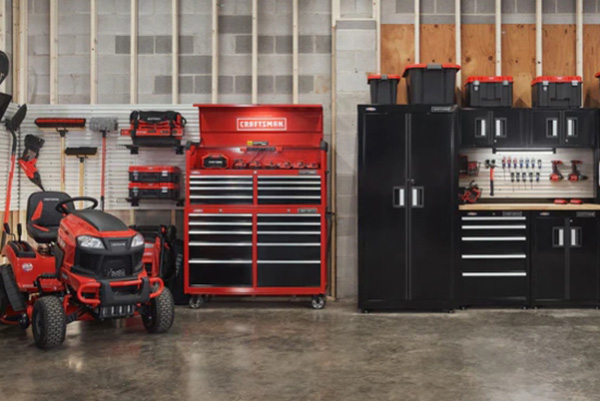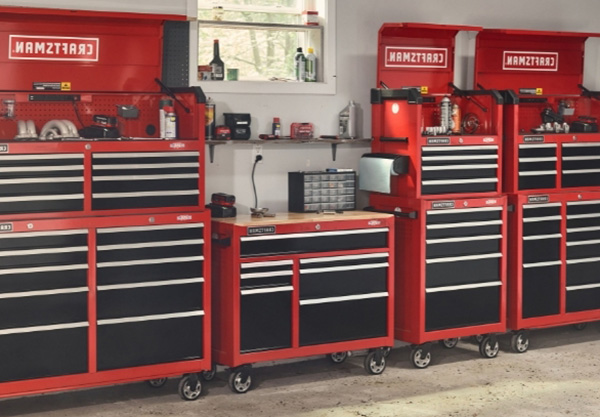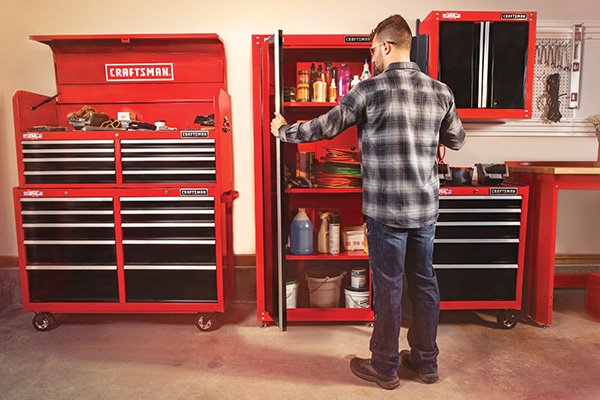Hello, my name is Allen, and for over a decade, I've been on the factory floor, overseeing the production of tool storage solutions that are shipped worldwide. From bustling automotive workshops in the USA to dedicated DIY garages in Australia, I've learned what professionals and procurement officers truly need. This isn't just another article about tool storage. This is an insider's guide. I'll walk you through the critical details—from steel gauge to drawer slide capacity—that separate a good tool cabinet from a great one. If you're looking to make a smart investment in your garage storage, keep reading. We'll explore how to maximize your space, secure your valuable tools, and choose a product that will serve you for years to come.
What Defines a High-Quality Steel Tool Cabinet?
When customers like Mark, a seasoned procurement officer from the USA, visit our factory, his first question is always about materials. The foundation of any durable tool cabinet is, without a doubt, its steel. The term "steel construction" is used widely, but the specifics are what count. The most important factor is the gauge of the steel. In simple terms, a lower gauge number means thicker, more robust steel. For a professional shop or high-use environment, you should look for a cabinet built with 16- to 18-gauge steel for the frame and 18- to 20-gauge for the drawers. This thickness prevents the frame from warping under a heavy load and ensures the drawers don't buckle.
Another critical aspect is the finish. A high-quality tool cabinet will have a powder-coated finish, not just a layer of paint. Powder coating is electrostatically applied and then cured under heat, creating a hard finish that is far more resistant to chipping, scratching, and fading than standard paint. This is crucial in a workshop environment where tools, chemicals, and daily wear-and-tear are a constant. We've found that this type of durable finish is a major selling point for hardware retailers who need to assure their customers of the product's longevity.
Finally, look at the welding and assembly. Are the corners clean and fully welded? Is the construction rigid? If you press down on the top of the cabinet, does it flex or feel solid? These small details are what separate a premium product from a cheap imitation. A well-built tool storage unit is an investment in efficiency and safety for any workspace.
How Can a Side Cabinet Maximize Your Workshop Organization?
As your tool collection grows, even the largest tool chest can start to feel cramped. This is where a side cabinet becomes an indispensable accessory. A side cabinet is designed to mount directly onto your main rolling tool cabinet, instantly expanding your storage capacity without taking up a significant amount of additional floor space. Think of it as vertical expansion. It's an incredibly efficient way to organize taller items like spray cans, power tool cases, or specialized equipment that don't fit well in standard drawers.
The real benefit of a side cabinet is tailored organization. Many designs come with adjustable shelves, allowing you to customize the interior to fit your specific needs. You can set one shelf with more height for large items and another with less for smaller containers or manuals. This level of customization transforms a generic storage solution into a personalized workstation. For professionals in automotive repair or construction, this means less time searching for the right tool and more time focused on the project at hand.
From our experience, customers who initially just buy a main tool cabinet often return to purchase a matching side locker later. Our advice is to consider it from the start. A combination of a chest and a side cabinet creates a comprehensive and highly organized workspace. It keeps your most frequently used hand tools in the chest's drawers for quick access, while the side unit can store bulkier items, keeping your entire shop looking clean and professional.

Understanding Drawer Load Capacity: What's the Real Weight Capacity?
One of the most common points of failure in a low-quality tool chest is the drawers. A drawer that sags, sticks, or collapses is not only frustrating but also a safety hazard. That's why understanding drawer load capacity is essential. When we list a weight capacity, say 100 lb per drawer, that figure is based on rigorous testing. It represents the maximum weight the drawer can handle without affecting its smooth operation.
The secret to a high load capacity lies in the drawer slides. Look for cabinets that use ball-bearing slides. These are superior to friction slides in every way. They provide a smoother, quieter motion and can handle significantly more weight. High-end models often feature double ball-bearing slides on deeper drawers, which are intended for holding heavy power tools or large socket sets. When you're inspecting a product, pull a drawer all the way out. It should glide effortlessly and not dip or wobble, even when fully extended.
But it's not just about the slides. The construction of the drawer itself matters. The edges should be rolled to add strength and prevent flexing. The gauge of the steel used for the drawer body contributes to its overall rigidity. For businesses that supply construction companies or industrial clients, guaranteeing a reliable weight capacity is non-negotiable. It's a core feature that ensures the tool storage unit can withstand the demands of a heavy-duty environment. It’s a detail we, as a factory, focus on intensely because we know it’s what keeps professionals safe and efficient.
Are the Locking Systems on a Modern Tool Chest Genuinely Secure?
For any professional, tools are a significant investment. Securing them is a top priority. A common pain point I hear from clients is a concern over the security of their tool storage. A simple lock and key might deter a casual thief, but a truly secure tool chest needs a more robust locking system. Most quality cabinets today use a tubular cam lock system. These locks are much harder to pick than standard flat-key locks, offering a higher level of security.
A key feature to look for is an internal, single-lock mechanism. This means that one key turn on a central lock secures all the drawers simultaneously. This is far more convenient and secure than having to lock each drawer individually. The mechanism typically involves a long metal bar that runs down the side of the cabinet internally, engaging with each drawer when locked. When you're evaluating a tool cabinet, test the locking system. It should feel solid and engage smoothly. There should be no "play" or wiggle in the drawers once they are locked.
For procurement officers like Mark, who supply automotive workshops or maintenance providers, the security of a tool box is a major selling point. They need to assure their customers that their expensive diagnostic equipment and specialized hand tools will be safe. We also offer options for more advanced electronic or combination locks for environments requiring even higher security. Ultimately, a good locking system provides peace of mind, ensuring that your valuable tools are protected when you're not around. It's a small part of the overall design, but its importance cannot be overstated.
Choosing the Right Size: Why Height, Width, and Depth Matter for Your Garage
"Will it fit in my space?" This is one of the first questions we address. The size of your tool cabinet is not just about storage capacity; it's about how it integrates into your garage organization and workflow. Before you even look at the price or features, measure your available space. Consider the height, width, and depth. A tall, narrow cabinet might be perfect for a tight corner, while a long, counter-height tool chest can double as an additional workspace.
The depth of the cabinet is particularly important. A standard depth is around 18 inches, which is great for most garages and workshops. However, for those who need to store larger power tools or cases, a deeper cabinet of 24 inches might be a better solution. This extra space is invaluable, but you must ensure you have enough room to walk around the cabinet and fully open the drawers without obstruction. Remember, a fully extended 24-inch deep drawer will require nearly four feet of clear space in front of it.
The height of the cabinet should also align with your needs. A waist-high tool chest with a solid top (often wood or stainless steel) provides an excellent surface for assembly or repair work. Taller cabinets, often called tool lockers, are better for storing bulky items on shelves. When planning your garage storage, think about a modular approach. You can start with a rolling base cabinet and later add a top chest and a side locker as your needs grow. This allows you to build a custom storage solution that perfectly fits your space and your tool collection.

From Pro Automotive Shops to DIY Garages: Finding a Versatile Tool Storage Solution
The needs of a professional automotive shop are very different from those of a weekend DIY enthusiast. Yet, both need the same fundamental thing: effective tool organization. The key is versatility. As a manufacturer, we design our product lines to cater to this wide range. For the pro user, features like heavy-gauge steel, high-capacity drawer slides, and integrated power strips are essential. Their tool cabinet is a daily-use workhorse. We offer products like our fully enclosed seven-drawer tool cabinets that provide maximum security and organization for a professional setting.
For the DIY hobbyist or a smaller garage, the focus might shift slightly. While durability is still important, factors like a smaller footprint, mobility, and price become more prominent. A smaller rolling tool cart or a portable tool box might be the perfect solution. These options provide excellent storage and can be easily moved around a project car or tucked away when not in use. Many of our customers in this segment appreciate the flexibility of a combination set, like a base cabinet with a removable top chest.
The beauty of a well-designed tool storage system is its ability to adapt. For example, the same side locker that a craftsman uses to store woodworking clamps can be used by a mechanic to hold bottles of oil and coolant. The best suppliers offer a range of various sizes and configurations. This allows procurement officers to select a curated inventory that serves multiple customer bases, from large-scale industrial clients to individual homeowners looking to tidy up their garage.
"The first thing I noticed was the build quality. In my business, I can't afford to sell my clients a tool box that will fail in a year. The welds are clean, the powder coat is thick, and the drawers slide like they're on ice. It's the kind of product that gives me confidence." - A satisfied procurement partner.
Why is a Mobile Tool Cart a Smart Addition to a Stationary Cabinet?
A large, stationary tool cabinet is the anchor of any serious workshop. It’s the central hub for your entire tool collection. But what happens when you're working on the other side of the shop, or under a vehicle? Constantly walking back and forth to grab tools is inefficient. This is where a mobile tool cart becomes a game-changer. It's a smart, practical addition that drastically improves workflow.
A tool cart, also known as a tool trolley, is essentially a compact, rolling cabinet. You can load it with all the specific sockets, wrenches, and power tools you need for a particular job and roll it right to your work area. This keeps everything within arm's reach. We produce a variety of these, from simple three-tiered shelves models like our economical tool trolley to carts with lockable drawers for added security. The casters are a key feature here; look for heavy-duty, ball-bearing casters, with at least two that swivel and lock. This ensures the cart is easy to maneuver but stays put once you've positioned it.
Many professionals use a combination system. Their main tool chest holds their complete inventory, while one or two smaller carts are set up for specific, recurring tasks (e.g., a "brake job" cart or an "electrical work" cart). This level of organization saves an incredible amount of time. For a business owner, time is money. Investing in a mobile tool cart is a low-cost way to boost productivity in any repair shop, warehouse, or assembly line.
The Importance of Heavy-Duty Steel Construction in Industrial Tool Storage
In a standard garage, a tool cabinet has a relatively easy life. In an industrial setting—a factory floor, a maintenance bay for heavy machinery, or a large-scale construction site—the demands are exponentially higher. This is where the term "heavy-duty" goes from a marketing buzzword to an absolute necessity. Industrial tool storage must be built to withstand constant use, heavier loads, and harsher environments.
The primary difference is the steel construction. Industrial-grade cabinets use the thickest gauge steel (often 14- or 16-gauge for the frame) and feature reinforced corners and bases. The entire frame is often continuously welded for maximum rigidity, preventing any twisting or flexing when the cabinet is being moved or subjected to a heavy load. The casters are also upgraded to handle thousands of pounds, not hundreds.
Furthermore, features like reinforced work surfaces are common. A 1/4-inch steel plate top, for instance, can be used for light fabrication or assembly without fear of damaging the cabinet. The drawers in an industrial tool chest will have the highest possible weight capacity, often exceeding 200 lb per drawer, thanks to double-slide mechanisms. These units are not just for storage; they are an active part of the industrial workflow. For our clients who supply these sectors, we emphasize these heavy-duty features and provide the compliance certifications to back them up, ensuring the product meets all workplace safety standards.

How Does a Side Locker Accessory Enhance Your Main Tool Cabinet?
A side locker is more than just an add-on; it’s a strategic upgrade that can fundamentally change how you use your tool cabinet. While drawers are perfect for hand tools, sockets, and smaller items, they are inefficient for storing bulky or long objects. A side locker is a tall, single-door cabinet that mounts to the side of your main unit, designed specifically to solve this problem. It’s the perfect place for things like pry bars, long-handled screwdrivers, cordless drills, and even work jackets or coveralls.
The utility of a side locker is enhanced by its interior features. Most come equipped with a combination of adjustable shelves and a pegboard-style inner door panel. The shelves provide bulk storage, while the pegboard allows you to hang frequently used items for immediate access. This level of tool organization is a massive boost to efficiency. Imagine opening the door and having all your air tools or battery chargers neatly arranged and visible, rather than tangled in a deep drawer.
From a factory perspective, we design our side locker units to be a universal fit for our corresponding tool chest series. The pre-drilled holes and included hardware make the mounting process easy and secure. For a procurement agent, offering a side locker as an optional accessory is a smart sales strategy. It allows customers to expand their storage as their needs evolve, fostering brand loyalty. It transforms a one-time purchase into a modular system, a complete storage solution that grows with the user.
Navigating Price and Product Range: What to Expect from a Manufacturer
One of the biggest challenges for buyers is understanding the price differences between various tool cabinet models. Why does one product cost twice as much as another that looks similar? As a manufacturer, let me break it down. The price is a direct reflection of materials, features, and build quality.
| Feature Tier | Materials & Construction | Drawer Slides | Locking System | Typical User |
|---|---|---|---|---|
| Entry-Level/DIY | 20-22 Gauge Steel, Painted Finish | Friction or Light-Duty Ball-Bearing | Basic Wafer Lock | Home Garage, Hobbyist |
| Pro-Sumer | 18-20 Gauge Steel, Powder Coat | 100 lb Ball-Bearing | Tubular Cam Lock | Serious DIY, Light Commercial |
| Professional/Industrial | 14-18 Gauge Steel, Reinforced Frame | 150-200+ lb Ball-Bearing (Double Slides) | High-Security Internal Lock | Automotive Shop, Industrial |
As you can see, a higher price gets you thicker steel, a more durable finish, higher drawer capacity, and better security. For a hardware retailer, it’s crucial to offer a range of products that covers these different tiers. This allows you to cater to a customer looking for a budget-friendly tool box for their basement, as well as a professional mechanic who needs a top-of-the-line tool chest. When dealing directly with a factory like ours, you can often get better price points and even discuss customization options, such as a specific color or branding, to make the product unique to your market. We understand that our partners need to be competitive, so we work to provide the best possible quality for the price. If you're looking for a variety of tool sets, for example, we offer everything from a basic 32 Pcs Tool Kit to comprehensive professional sets. Clear communication about your target market and needs is the key to finding the right supplier and the right product.
Key Takeaways to Remember
- Quality is in the Details: Don't just look at the tool cabinet; inspect it. Check the steel gauge (lower is thicker), the finish (powder coat is best), and the quality of the welds.
- Drawers are Crucial: Opt for ball-bearing slides for smooth operation and high load capacity. Ensure the drawers feel rigid and don't sag when extended.
- Think Modular: Your storage needs will grow. A system that allows you to add a top chest, side cabinet, or side locker later is a smart, long-term investment.
- Security Matters: A tubular lock with a single, internal locking mechanism offers good security for most applications. Protect your investment in tools.
- Mobility is Efficiency: A rolling tool cart is not a luxury; it's a productivity tool. It complements a stationary cabinet perfectly by bringing the tools to the job.
- Choose the Right Supplier: A good manufacturing partner will be transparent about materials, provide legitimate certifications, and communicate clearly to ensure you get the right product for your customers.
Post time: 07-18-2025



